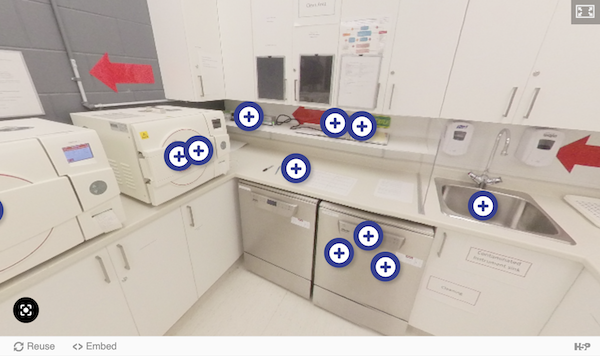In this Issue: Some Summer News, Updates, and EdTech Highlights
-
- Audio Editing Software: Audacity TOS Update and Recommend Alternatives
- Get Ready to Zoom at USask!
- H5P Highlight: Create an Interactive 306° Virtual Tour
- DEU Summer Reading Recommendations:
- DEU support and contact information
Audio Editing Software: Audacity TOS Update and Recommend Alternatives
Audacity is a digital audio editor and recording application software that educators and instructional designers have been using and recommending to students for many years. In April 2021, the software was acquired by a new company, and while it is still free to download, a July 2021 update to its terms of service now allows the software to collect “data necessary for law enforcement, litigation and authorities’ requests”. This change has been met with a great deal of controversy, and as such many users are reconsidering their use of this software.
As an open-source project, there is hope that a “forked” version of Audacity without invasive data collection will soon be available. However, until then, here are a few alternatives to Audacity to consider for your own use, or for recommending to students:
Panopto, https://usask.cloud.panopto.eu/ – A USask-supported option! While many think of Panopto as being primarily for video creation, editing, and streaming, it also supports audio-only projects. The editing functions are relatively simple, but do allow you to cut, insert, and splice portions of audio together. For information on getting started in Panopto, see this Knowledge Base article.
-
- Ocenaudio, https://www.ocenaudio.com/ – Free to download and use. Available for Windows, Linux, and Mac OS.
- Wavosaur, https://www.wavosaur.com/ – Free to download and use, but Windows only.
- Audiodope, http://www.audiodope.org – Free to download and use, but Windows only.
- REAPER, https://www.reaper.fm/ – A more full-featured digital audio workstation (DAW) with a cheaper ($60 USD) option for students and educators. Available for Windows, Linux, and Mac OS.
- Older versions of Audacity – Versions up to and including version 3.0.2 do not collect any data! If you have these installed on your computer, you are not subject to the new TOS. Older versions of Audacity can still be downloaded; see more info at https://blog.fosshub.com/audacity-old-version-without-data-collection-telemetry/
Get Ready to Zoom at USask!
 In fall 2020, a project was launched to ensure that the university community has web and video conferencing software that meets our needs given our increased reliance on these tools for teaching, working, learning and research. As a result, USask has awarded our web conferencing contract to Zoom. The decision to move to Zoom was based on the input we received via the web conferencing needs assessment and vendor demonstrations. See full project details here.
In fall 2020, a project was launched to ensure that the university community has web and video conferencing software that meets our needs given our increased reliance on these tools for teaching, working, learning and research. As a result, USask has awarded our web conferencing contract to Zoom. The decision to move to Zoom was based on the input we received via the web conferencing needs assessment and vendor demonstrations. See full project details here.
Zoom will be available on August 3rd, allowing all Faculty, Staff and Students to host web conferences with up to 300 attendees. WebEx will continue to be available until it is fully decommissioned in Spring 2022. All details regarding the Zoom functionality and the launch will be available in the Web Conferencing Channel in PAWS in the next two weeks. In the meantime, please visit the FAQs for the most up to date information.
Training dates have been set for the end of July and users can enroll here using IT Training’s new Training Catalogue : https://usask.ca-central.catalog.canvaslms.com/. This new registration system uses Canvas Catalog for which IT Training has provided a How-to video on using the new catalog system.
More dates will be set for the end of August and throughout the fall term. Questions or concerns can be directed to webconferencing@usask.ca
H5P Highlight: Create an Interactive 360° Virtual Tour
Following from a past issue of the DEU Digest, today we want to highlight another one of the H5P interactive content types that we think is really, really cool: the Virtual Tour (360).
The Virtual Tour (360) is just what it sounds like. Start with a 360 (equirectangular) image of a real place – either taking it from Creative Commons source, or by capturing it yourself with a smartphone or 360 camera. Then add in additional text, images, sounds, videos, or interactive quiz-type questions to allow your students to explore and learn more about the space.
Here are a few examples to check out:
-
- Dental Reprocessing Lab Simulation Tour (dentistry, health science) – A pre-lab orientation/simulation, created for Dental Hygiene students at Cambrian College to become familiar with the lab, its procedures, equipment, and the location of supplies, all before they enter the real lab.
- Roman Theatre (history, archaeology) – Explore and learn more about the Roman Theatre in Petra.
- Mount McKay Virtual Field Trip (biology) – Offers students a chance to identify some local species as part of a plant ecology lab.
Do these Virtual Tours give you any ideas for your own teaching? Contact deu.support@usask.ca for more information and support with creating H5P-based digital learning resources!
Dental Reprocessing Lab Simulation Tour – Sarah Wendorf, Instructional Designer, Cambrian College
DEU Summer Reading Recommendation: How humans learn: The science and stories behind effective college teaching
Joshua Eyler, Director of Faculty Development and Lecturer of Writing and Rhetoric at the University of Mississippi, draws upon research in teaching and learning, conversations with colleagues, classroom observations, and personal experience. The resulting work is an approachable resource connecting an overview of research and theory, to stories illustrating key findings and professional growth. Presented across five broad themes of inquiry—curiosity, sociality, emotion, authenticity, and failure—each chapter provides practical, actionable advice. Whether you are new to teaching in higher education or have a depth and breadth of experience, this book has something for you.
If you prefer to listen, How humans learn is available as an audiobook. The Saskatoon Public Library happens to have a copy which you could borrow through the Hoopla app.
Although How humans learn was published only a few years ago, plenty has happened since then. Inside Higher Education published several follow-up interviews with the author extending and elaborating on the themes and takeaways presented in the book:



